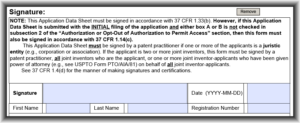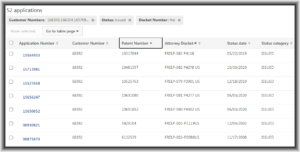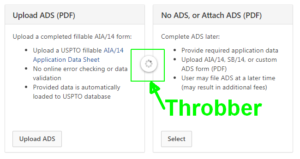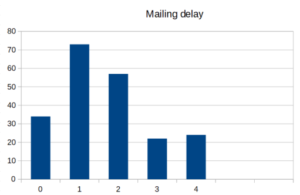
Get rid of or correct or improve the “boy who cried wolf” nag message in Patentcenter about paying fees.
This is Feature Request FR25. Continue reading “Get rid of or correct or improve the “boy who cried wolf” nag message about paying fees”

Bluesky: @oppedahl.com

Get rid of or correct or improve the “boy who cried wolf” nag message in Patentcenter about paying fees.
This is Feature Request FR25. Continue reading “Get rid of or correct or improve the “boy who cried wolf” nag message about paying fees”

When an ADS turns out to be unsigned, or not correctly signed, or not signed by a practitioner, it leads to a cascade of problems. It often takes months or a lot of money, or both, to fix the problems. It would be trivially easy for Patentcenter to check an uploaded computer-readable Form PTO/AIA/14 (Application Data Sheet) such as we see at right, for a signature. But Patentcenter does not do so.
Patentcenter should check an uploaded ADS for a signature and should display warnings as needed. This is Feature Request FR24. Continue reading “Patentcenter should check uploaded ADS for a signature”

When a filer uploads Form PTO/AIA/14 (Application Data Sheet), Patentcenter should carry out validations. As mentioned here, Patentcenter should validate priority claims against DAS. This blog article points out that Patentcenter should validate the “non-inventor applicant” excuse field.
This is Feature Request FR23.
Continue reading “Patentcenter should validate the “non-inventor applicant” excuse field”
What are the consequences of filing a US patent application with an Application Data Sheet (“ADS”) that was unsigned, or incorrectly signed? Many, many bad things can flow from this. The bad things can cascade and it can take months of tedious step-by-step filings to get things straightened out. Continue reading “Consequences of an unsigned (or incorrectly signed) ADS”
Getting a priority claim wrong in a patent application is a serious matter. There’s a super-simple thing that ePCT does to prevent many ways of getting priority claims wrong, that Patentcenter fails to do. Of course Patentcenter should do the same validation that ePCT does — cross-checking against DAS. I’ll explain. Continue reading “Patentcenter should validate priority claims against DAS”

The coders who designed the Patentcenter workbench made a mistake in the “sort by patent number” function. This is listserv trouble ticket number CP33. Continue reading “Patentcenter’s “sort by patent number” does not work correctly”

I bet I got your attention with that title! Nope, I think it is extremely unlikely that whatever the title made you think of has anything at all to do with the feature of USPTO’s Patentcenter that this article is going to talk about. Continue reading “How your reptile brain reacts to an animated image of a throbber”
Readers will recall my recent sense of discouragement with USPTO’s handling of its Patentcenter rollout. But yesterday there was an encouraging event. I think there is some reason for guarded optimism that USPTO may do better going forward in its handling of its Patentcenter rollout. Continue reading “An encouraging step with Patentcenter”

(Update in December of 2023: the developers have made changes to the Examiner lookup in Patent Center that fix some, but not all, of the defects that we reported to the USPTO in 2020. See parenthetical updates below.)
One of the core design principles for Patentcenter, USPTO has said from the beginning, is that each feature of PAIR and each feature of EFS-Web will be replicated in Patentcenter. The idea is that once the USPTO manages to replicate each and every feature of PAIR and EFS-Web into Patentcenter, and manages to get all of the programming mistakes fixed, and manages to get it to scale well under load, then USPTO will shut down PAIR and EFS-Web. This blog article describes yet another defect, this time the Examiner lookup feature for an application in your workbench. Continue reading “A defect in Patentcenter — Examiner lookups don’t work like they do in PAIR”

(This is Patentcenter trouble ticket CP31.)
The designers of Patentcenter got it seriously wrong when they picked the default setting for the display of “Outgoing Correspondence”. The result for practitioners who until now have been accustomed to the default setting in EFS-Web is that the “Outgoing Correspondence” feature of Patentcenter is a trap for the unwary. Continue reading “Poorly designed “outgoing correspondence” default setting in Patentcenter”